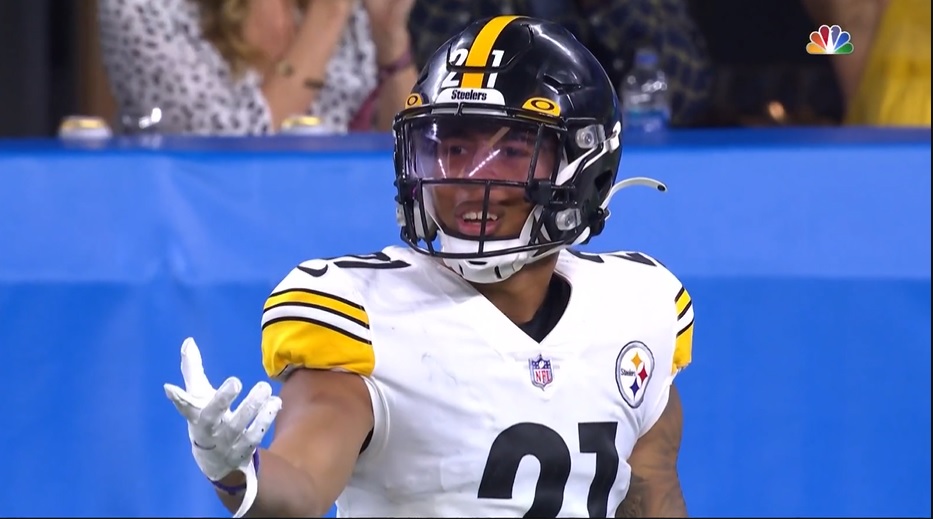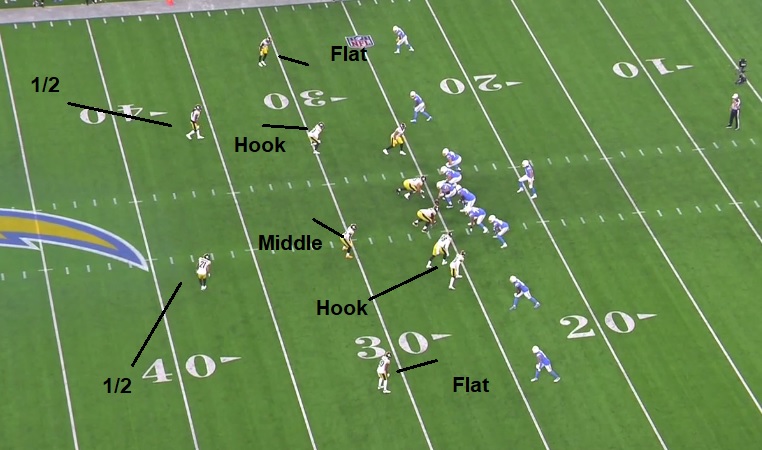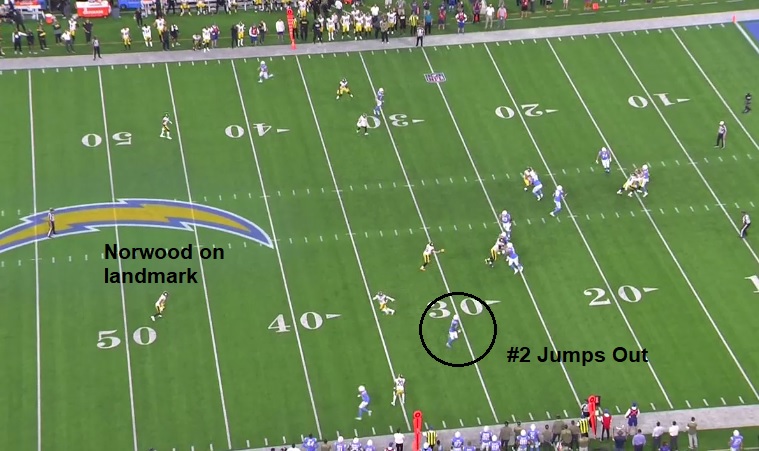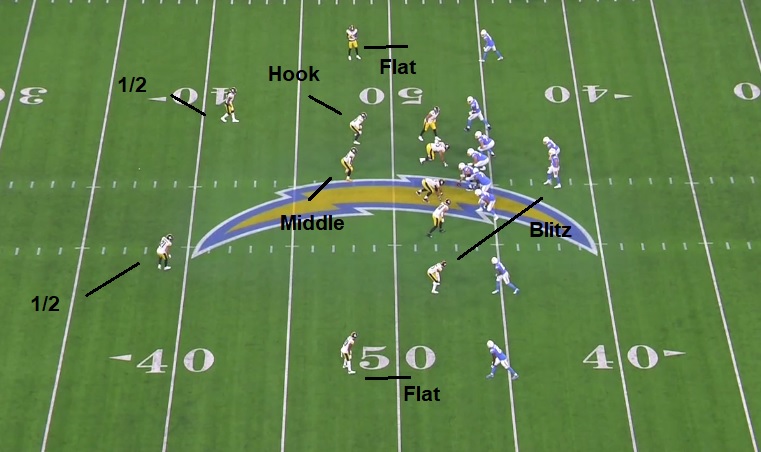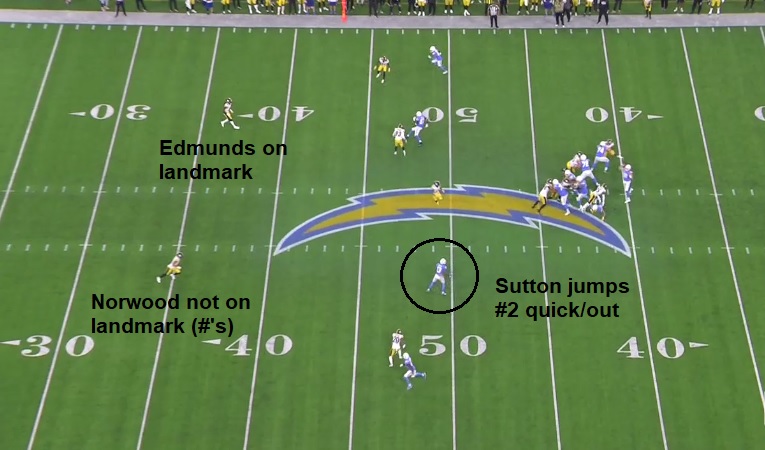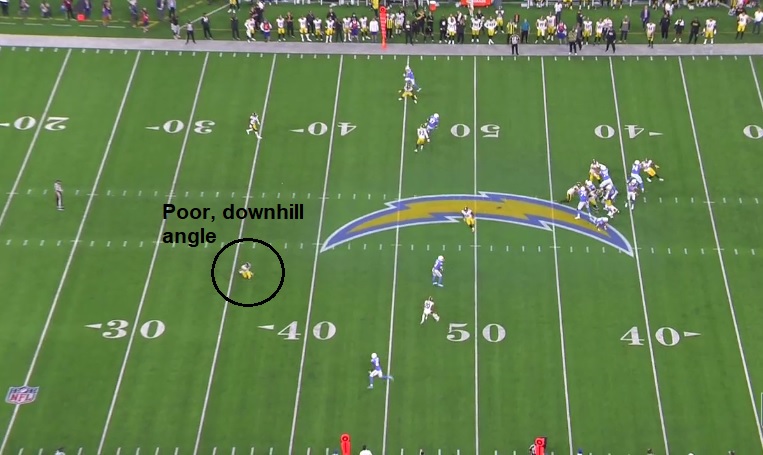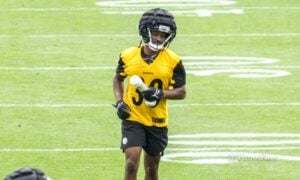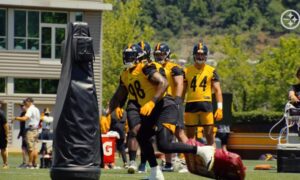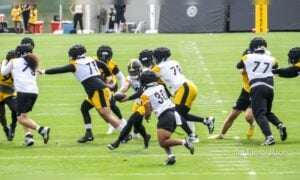After spending three quarters barely hanging on, the Pittsburgh Steelers’ defense finally got stops in the fourth quarter. Until they didn’t. Pittsburgh needed just one more stand to complete a Sunday night comeback for the ages. But Justin Herbert hit Mike Williams deep down the left sideline, wide open, for a 53-yard touchdown and the final score of this shootout.
So what happened?
The answer seems pretty clear. Let’s dive into the breakdown that broke the Steelers’ hearts.
Before we delve into the touchdown, we need to look at plays run earlier in the game. After the win, Justin Herbert and Mike Williams said they saw something before the TD that clued them into thinking they could take a shot downfield. The first comes on Cam Sutton’s INT off Cam Heyward’s tipped pass. As Dave Bryan noted on Twitter, it’s the a similar route combination, #2 curl/out with #1 vertical and the Steelers in Cover 2.
Fast-forward to the first play of the game-winning drive, 1st and 10 from the 25. Chargers come out in empty with two receivers to each side and a tight end attached to the line. Pittsburgh, as they did all three plays of this drive, is playing two high. Here, it’s Cover 2, a staple concept Mike Tomlin grew up around, part of the Tony Dungy “Tampa 2” tree. Rush four, drop seven (with NCB Arthur Maulet faking a blitz and then dropping on the snap).
Assignment-wise, safeties play the deep 1/2. The numbers are their landmark. In 2014, here’s how analyst Matt Bowen described the safeties’ job in C2 (Bowen, a former NFL safety himself).
“- In Cover 2, both safeties (free/strong) are responsible for the deep halves of the field and fill the “alley” (between cornerback and edge of formation) versus the run game. They align at a depth of 15 yards and work to 18 yards at the snap with the top of the numbers as their zone landmark. The safeties read the release of the No. 1 wide receiver for their run/pass key and play “top-down” while overlapping any throw to the deep middle of the field.”
The corners play the flat with the underneath defenders playing hook and middle zones. This is more “traditional” Cover 2, not Tampa 2, with the middle defender opening to the strength and carrying the seam, like Derrick Brooks did throughout his career.
Here’s how it looks.
To the bottom, the #2 receiver runs an out route. With Sutton playing the flat, he tries to jump and trap the route, able to do so with Norwood carrying anything vertical. The play is a screen, a five-yard completion to TE Donald Parham, so the ball wasn’t designed to go to #2 or #1. Note Norwood reaching his landmark here, on top of the numbers.
Here’s a look at the play below.
Pittsburgh played 2 Man, a man coverage, the next snap, and Herbert checked down to Austin Ekeler underneath for a gain of 17.
Now we get to the touchdown. 1st and 10 from the Chargers’ 47. They come out in 2×2, similar to the first example but with the running back in the backfield. Pittsburgh again responds with a two-high look and are playing Cover 2, the same coverage as the above example. Should be same assignments across the board. Safeties play deep 1/2 to take away anything vertical, corners have the flat. The only difference here is the lack of the hook defender to the bottom with NCB Arthur Maulet blitzing this time, making it a five-man pressure.
This time, #2 doesn’t run an out route like before, settling on a curl underneath, probably recognizing the Cover 2 and not wanting to run himself into the flat defender. But Sutton still drives on the football, trying to occupy two zones with Maulet blitzing and no longer the hook defender.
For some reason, Tre Norwood does the same. Instead of gaining depth and getting to his landmark (again, the numbers), he stops getting width and begins breaking and driving downhill. It looked like he guessed Herbert would throw the underneath pass to #2, as he attempted on the Sutton pick.
Compare Norwood to Terrell Edmunds, on his landmark as James Pierre jumps #2 out to the top.
That leaves Mike Williams, #1 to the bottom, running free down the sideline. And Herbert hits him. To make matters worse, Norwood’s initial angle trying to rally to Williams is also poor. He’s coming downhill and too sharp, running to where Williams was currently at, not where he was going to end up.
Not only does Norwood now allow the catch uncontested, he’s trailing the whole way downfield. Give up the catch and make the tackle after 20-25 yards is one thing. It’s ugly but keeps the defense on the field and a three-point lead intact. Give up the touchdown and now the Steelers have to respond. Which is what happened and obviously, failed.
Some could argue Sutton should’ve done a better job re-routing Williams inside. You see that a lot with Cover 2 from years ago. Funnel the WR inside so the safety has less ground to cover. But honestly, I don’t see the Steelers do much of that anymore. And you see Sutton in these clips align with inside leverage. Watch James Pierre to the top and you don’t see much of a reroute. You see it more in the first clip, the screen pass, but the receiver is being pushed to the sideline, not inside.
Norwood could have and should have made the play here. It’s not easy, Cover 2 has the weakness of that ‘honey hole” between the corner and safety. But Norwood didn’t do his job here. He tried doing someone else’s and got burned for it.
I get it. Norwood is a rookie. And he’s played well this season. Heck, he seemed to play well leading up to that moment. Like Pat Freiermuth’s costly fumble against Detroit, one play doesn’t define his season and Norwood’s future remains bright. But we don’t need to sugarcoat the error. It was a massive one, a simple coverage breakdown that decided the game’s outcome.

